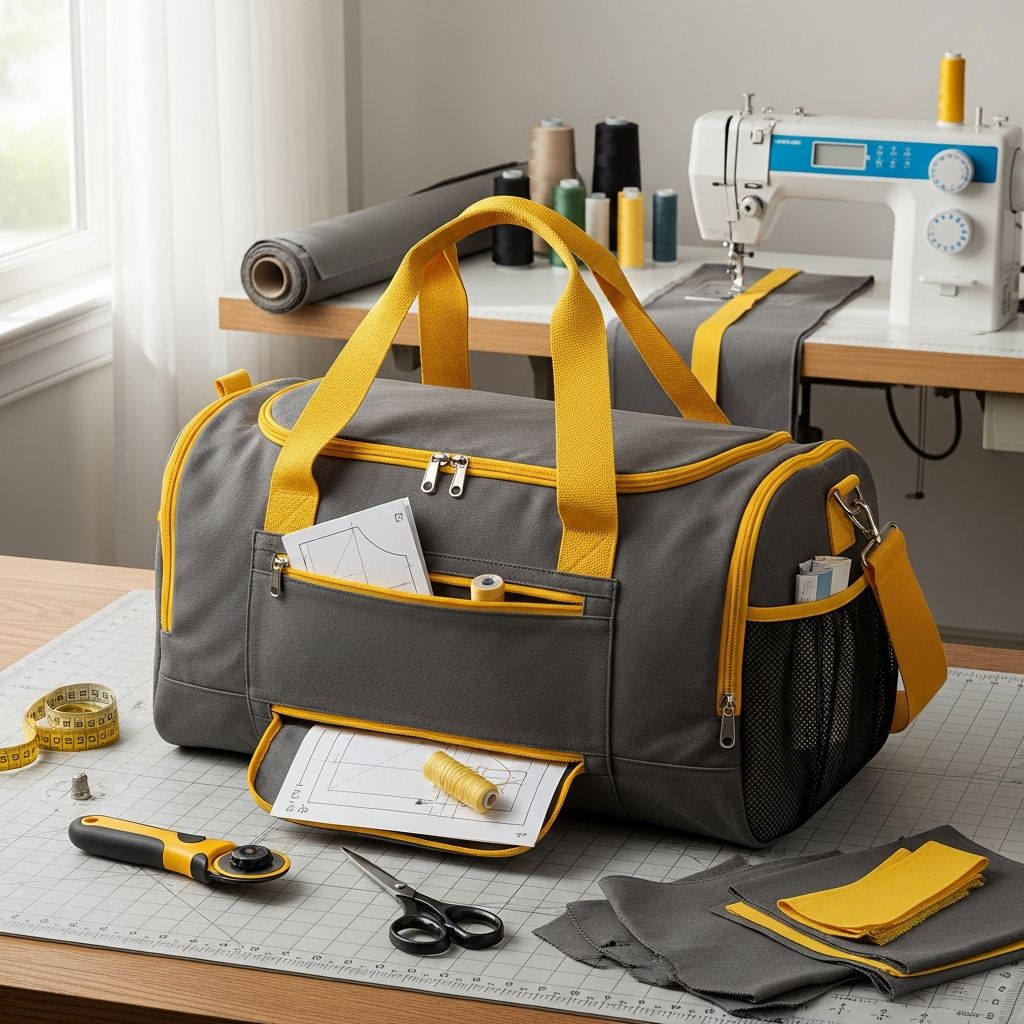DIY Gym Bag: Step-by-Step Sewing Guide for a Custom Duffel
Sew your own durable, personalized gym duffel bag with this detailed, beginner-friendly tutorial.

How to Make a DIY Gym Bag: A Complete Step-by-Step Sewing Tutorial
Personalizing your workout accessories can add motivation and flair to your fitness routine. This detailed guide will walk you through sewing your own stylish gym duffel bag from scratch. Whether you’re looking for a unique gift or a practical addition to your gym essentials, this project is an ideal way to combine utility and creativity, regardless of your sewing skill level. Let’s get started!
Materials and Tools Required
- Sturdy woven fabric (at least 1–1.25 yards; cotton canvas or duck cloth recommended)
- Fabric scissors
- Straight pins or sewing clips
- Sewing machine
- Coordinating thread
- Fabric chalk or pen for marking
- Yardstick or measuring tape
- Iron and ironing board
- Optional: lining fabric (for extra durability and structure)
- Optional: webbing or additional fabric for straps/handles
- Optional: Zipper or drawstring (for top closure if desired)
Cutting the Fabric
To start, prepare your bag’s main body and ends:
- For the bag body: Cut one piece of main fabric measuring 27 inches wide by 40 inches tall.
- Divide the main piece: Cut this piece in half to create two rectangles, each 27 inches x 20 inches. Set these aside.
- For the circular ends:
- Fold your remaining fabric in half twice, creating four layers.
- Using a 12-inch embroidery hoop or a round object as a template, trace a circle onto the top layer.
- Carefully cut along the outline, going through all layers to yield four circles.
Preparing the Bag Pieces
Before assembling, you can customize your pieces for added structure or visual interest.
- Stabilizer or interfacing: For a sturdier bag, iron-on fusible interfacing to the wrong side of each rectangular and circular piece before sewing.
- Lining (optional): Repeat the cutting process above using lining fabric to add a professional touch and protect the inside.
- Pockets (optional): Use leftover fabric to create interior or exterior flat pockets. Stitch these to the interior or exterior rectangles prior to assembling the bag.
Sewing the Body Panels
- Lay both rectangles right sides together.
- Pin or clip along the two shorter sides (20-inch edges). These will become the bag’s sides.
- Sew with a 1/2-inch seam allowance, then finish the raw edges with a zigzag stitch or serger for extra durability.
- Press the seams open with an iron.
Attaching the Bottom Panel
If you wish, you can add a bottom panel for more structure. For the simplest style, skip this step and proceed directly with the next step.
- To make a separate bottom: Cut a rectangle the same length as your sewn body (about 27 inches) and your preferred width (typically 5–6 inches).
- Pin the bottom panel right sides together to the bag body’s lower edge, matching side seams. Sew and finish seams.
Shaping and Closing the Bag Sides
- With right sides facing, pin each circular end to one end of the main body tube, easing fabric evenly around the circle.
- Sew around each circle with a 1/2-inch seam allowance. Go slowly to avoid puckers, continuously adjusting the fabric as needed.
- Finish seams as desired (zigzag or serger).
This method results in a roomy, cylindrical bag ready for handles and final trims.
Making and Attaching Handles
Handles can be made from matching fabric, contrasting cotton webbing, or leather. For sewn fabric handles:
- Cut two strips: 4 inches wide by 24–28 inches long (adjust length based on personal comfort).
- Fold each strip in half lengthwise, right sides together, and sew along the long edge to form a tube. Turn right side out.
- Press the handles flat, with seam centered underneath.
- Topstitch both long sides for reinforcement and a professional finish (optional).
- Attach each end of both handles to the main body, spacing them evenly from the side seams and keeping them parallel.
- Pin and topstitch in a rectangular or X-box pattern for strong attachment (at least 2–3 inches down from the top edge).
Adding a Top Closure: Zipper or Drawstring (Optional)
- Zipper Closure: Cut a zipper slightly shorter than your bag length, place it along the top seam between outer fabric layers, and sew (see below for basic zipper insertion tips).
- Drawstring Closure: Fold over the top edge 1–1.5 inches, stitch to form a casing, leaving an opening at one side. Thread a thick cord or ribbon through with a safety pin.
- Velcro Closure: Attach strips of velcro to the inner edge of the top sides for a quick and easy fastening solution.
For a more advanced build, attach the zipper before closing the side seams. This makes sewing and topstitching easier, especially for beginners.
Optional Customizations & Embellishments
- Inner or outer pockets for keys, water bottles, or smaller items
- Contrast piping sewn into the circular side seams for definition
- Fabric paint, iron-on patches, or embroidery for decoration
- Removable or adjustable shoulder strap clipped to D-rings at either end
Finishing Touches
- Carefully turn the entire bag right-side out through one of the openings or the zipper/drawstring gap.
- Press all seams for a clean, crisp finish.
- Inspect your stitching and reinforce any high-stress points with extra seams or topstitching.
- Trim away any loose threads.
Your DIY gym duffel bag is complete! It should be sturdy, practical, and fully customizable to your preferred colors and features. Whether for daily workouts, overnight trips, or gifting, this project is as versatile as it is stylish.
Pro Tips & Troubleshooting
- Use a sharp needle suitable for thick fabrics if working with canvas or denim.
- Iron seams during construction to keep pieces flat and manageable.
- Pin/clip generously when sewing curves (circular ends) for even seams.
- Test your machine settings on fabric scraps before starting the main bag.
- If new to zippers, baste in place first or refer to a zipper installation tutorial for best results.
- For a machine-washable bag, prewash fabrics in advance to prevent shrinkage.
DIY Gym Bag Variations
- Recycle old jeans or sturdy textiles for an upcycled version with unique character.
- Add water-resistant lining for swim or sports gear by using waterproof fabrics.
- Make it mini for a kids’ activity bag by reducing all dimensions proportionally.
- Embellish the exterior with fabric decals, paint, or iron-ons for personal expression.
Care & Maintenance Tips
- If made with cotton, machine wash on gentle and air-dry to preserve shape and color.
- Spot clean synthetic or laminated fabrics as needed.
- Trim loose threads after each use to keep the bag tidy.
Comparison Table: DIY vs Store-Bought Gym Bag
| Feature | DIY Gym Bag | Store-Bought Gym Bag |
|---|---|---|
| Customization | Fully customizable: size, color, pockets, closure style | Limited; depends on available designs |
| Cost | Usually lower, especially with recycled fabrics | Varies; designer bags can be expensive |
| Durability | High if quality materials used and seams are reinforced | Generally sturdy, but quality varies |
| Satisfaction | High – sense of accomplishment and uniqueness | Moderate; depends on match between needs and product |
| Time Required | About 3–4 hours (including prep) | Immediate |
Frequently Asked Questions (FAQs)
Q: Do I need advanced sewing skills for this project?
A: No. This bag is suitable for beginners, especially if you skip optional extras like pockets or zippers. Basic straight and curved stitching is all that’s essential.
Q: What type of fabric is best for a gym bag?
A: Sturdy woven fabrics such as canvas, duck cloth, heavy twill, or upcycled denim provide durability and structure. Lighter fabrics may require interfacing.
Q: Can I machine-wash my finished gym bag?
A: Most cotton or canvas bags can be washed on a gentle cycle and air-dried. Spot clean bags with leather or vinyl handles as needed.
Q: How can I add extra structure to the bag?
A: Use interfacing or fusible fleece between the fabric and lining. This will help the bag stand up by itself and resist sagging.
Q: Is it possible to make an adjustable shoulder strap?
A: Yes. Attach fabric tabs or D-rings to the side seams and sew/cut a longer fabric or webbing strap. Add a metal slider for adjustability, and clip on with swivel hooks for a removable option.
Conclusion
Sewing your own gym bag is a rewarding project that combines function, personalization, and creativity. With a few materials, essential sewing tools, and this thorough tutorial, you’ll have a quality accessory ready for all your active adventures. Don’t hesitate to adapt, embellish, and innovate—your handmade duffel can be as simple or detailed as you like. Happy sewing!












